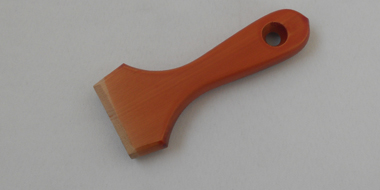
Process processes
Treatment of grass roots-primer-sanding paper-moisturizing powder-basic coloring, repairing-full batch of color putty-polishing-brush oil color-brush the first paint-repair putty-tinkering-sanding paper-brush the second brush varnish-brush cover paint
Operating process
(1) Treatment of the base: Use a scraper or glass piece to clean the surface of dust, glue, rust spots, take care not to scratch out burrs.
(2) Cover primer: panel, line and other decorative surface materials in front of the paint brush a varnish, required to be evenly painted, not leaky brush.
(3) Sand paper: The grinding layer is polished, polished with wood grain, and the first grinding line is used to grind four planes.
(4) Flour oil powder: The oil powder is rubbed repeatedly on the surface of the wood with cotton wire, the oil powder is rubbed into the brown eye, and then wiped with linen or wood wire. The residual powder on the wire corner is removed with bamboo chips. After the oil powder is dried, use the No. 1 sandpaper to smooth the wood pattern and smooth it until it is smooth. Protect the corners.
(5) Grassroots coloring, repair: The basic coloring of the finish is determined according to the paint color specified in the template, and is made of clear oil, light oil, etc.. The oil must not be too dilute, and it is appropriate to make porridge. Rub the head back and forth with a cut of about 20 to 40 cm, including edges and corners;
(6) Full batch of color putty: The color should be lighter than the model 1-2 %, putty oily size suitable. Use the operation to scrape putty into nail hole, crack and so on, scratch putty should be raised, putty should be shaved, do not leave loose putty. After the putty is dried through, use No. 1 sandpaper to gently polish, grinding to smooth, Tidal cloth to wipe powder ash.
(7) Sanding: The base of the finish is colored and the putty is flattened. After grinding, water sandpaper is used for grinding and leveling. After grinding, cloth is used to clean up. Again with the same color putty full scratch the second time, the requirements and scratch the head the same putty again. After scraping, use the same smudges to make up the putty at the corner of the nail and the missing edge, requiring full and flat scraping. After the dry sanding paper, grinding smooth. To achieve clear wood lines, do not wear through the corners, polished clean and clean with wet cloth, dry.
(8) Brush oil color: Brush action is fast, brush brush brush, brush, clean oil must be light, do not leave joint brush marks, each brush face to brush, not left joint, brush after the color is required to be consistent, not covered wood pattern, The brush procedure is the same as brush lead oil.
(9) Brush the first varnish: Brush the same color as the brush oil, and should use the worn out old brush. After the paint is thoroughly dried, use the No. 1 old sandpaper to thoroughly polish it. The head is basically polished off first and then cleaned with a damp cloth.
(10) Compensate putty: Use horn putty board, to be painted putty to be shaved clean, smooth, no putty scar, can not damage paint film.
(11) Modification: The surface of the dark spots, knot scars, putty scars and inconsistent color into a color, and painted wood.
(12) Sand paper: Use fine yarn paper to gently Polish back and forth, and then wipe the powder with a damp cloth.
(13) Brush the second and third varnishes: The surrounding environment should be clean and clean. The operation should be the same as the first varnish, but the action should be agile, multi-brush, full, non-falling, and smooth. After the paint is painted, the paint is partially ground and the wet cloth is cleaned. Then brush a piece of paint, and then use the sandpaper to polish, smooth, after grinding, repeat three times, required to achieve uniform thickness of the paint film, corner, corner and other waist grinding in place.
(14) Finally, brush the cover paint as required.


